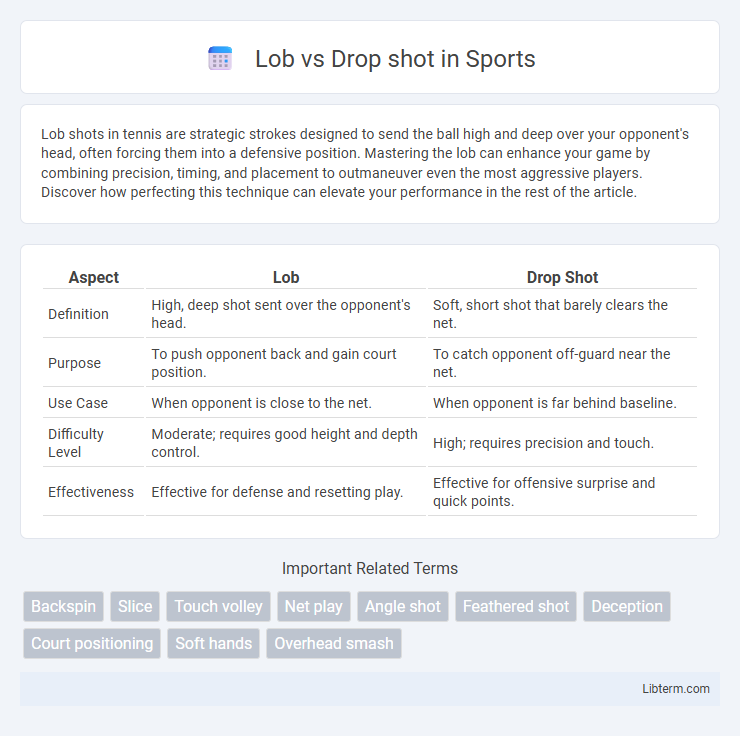Lob shots in tennis are strategic strokes designed to send the ball high and deep over your opponent's head, often forcing them into a defensive position. Mastering the lob can enhance your game by combining precision, timing, and placement to outmaneuver even the most aggressive players. Discover how perfecting this technique can elevate your performance in the rest of the article.
Table of Comparison
| Aspect | Lob | Drop Shot |
|---|---|---|
| Definition | High, deep shot sent over the opponent's head. | Soft, short shot that barely clears the net. |
| Purpose | To push opponent back and gain court position. | To catch opponent off-guard near the net. |
| Use Case | When opponent is close to the net. | When opponent is far behind baseline. |
| Difficulty Level | Moderate; requires good height and depth control. | High; requires precision and touch. |
| Effectiveness | Effective for defense and resetting play. | Effective for offensive surprise and quick points. |
Understanding the Differences: Lob vs Drop Shot
The lob and drop shot are distinct tennis techniques used to manipulate opponent positioning and court dynamics. A lob involves hitting the ball high and deep over an opponent to push them back, leveraging elevation and power for strategic defense or offense. In contrast, a drop shot is a delicate, short stroke designed to barely clear the net and fall rapidly, exploiting opponent's distance to the baseline for quick points.
Technical Breakdown: Mechanics of Each Shot
The lob requires an open racket face and a smooth upward swing to arch the ball high over the opponent, utilizing wrist flick for controlled height and depth. Conversely, the drop shot demands a delicate touch with minimal backswing, soft grip, and a gentle slice to reduce ball speed and cause it to fall just over the net. Mastery of these mechanics allows players to vary pace and trajectory effectively during rallies.
Strategic Applications in Match Play
Lobs strategically exploit an opponent's net positioning by sending the ball high and deep, forcing them to retreat or risk an overhead smash. Drop shots serve as precision tools to catch opponents off-guard near the net with a soft, low bounce that disrupts rhythm and opens the court. Effective match play combines lobs and drop shots to vary pace and positioning, maximizing pressure on opponents and creating scoring opportunities.
When to Use a Lob Shot
Use a lob shot in tennis when your opponent is positioned close to the net, allowing you to send the ball high and deep into the opponent's baseline area. This tactic forces opponents to retreat quickly, disrupting their offensive positioning and creating an opportunity for you to gain control of the point. Lobs are especially effective against aggressive net players and during defensive situations to regain court space.
Perfecting the Drop Shot Technique
Perfecting the drop shot technique involves precise control of touch and angle to gently send the ball just over the net, making it land close and difficult for opponents to reach. Unlike the lob, which requires height and distance to push opponents back, the drop shot demands subtle wrist action and timing to exploit open court space effectively. Mastery of the drop shot enhances tactical play by combining deception with accuracy to win crucial points.
Common Mistakes with Lobs and Drops
Common mistakes with lobs include hitting the ball too low, failing to clear the opponent's reach, and misjudging the ball's trajectory, resulting in easy volleys. With drop shots, players often strike with excessive force or poor touch, causing the ball to bounce too far from the net and lose its effectiveness. Mastering precise control, correct racket angle, and proper timing significantly improves the success rate of both shots in tennis or pickleball.
Defensive and Offensive Uses
A lob shot in tennis is primarily defensive, used to counter aggressive net play by sending the ball high over the opponent's reach, allowing time to recover position. The drop shot serves an offensive purpose, designed to catch opponents off guard by gently placing the ball just over the net, exploiting their distance from the baseline. Effective use of the lob and drop shot requires strategic awareness of opponent positioning and court dynamics to shift momentum during rallies.
Training Drills for Lobs and Drop Shots
Effective training drills for lobs and drop shots emphasize precision, control, and timing to enhance tactical play in tennis or pickleball. Practicing with targets placed at varying court positions develops accuracy and stroke consistency, while partner feed drills simulate match scenarios to improve shot selection under pressure. Incorporating footwork exercises alongside shot execution drills enhances players' ability to swiftly transition between defensive lobs and offensive drop shots, boosting overall court coverage and strategy.
Famous Players and Signature Shots
Roger Federer is renowned for his perfectly placed lob, often using it to counter aggressive net players and turn defense into offense seamlessly. Rafael Nadal's drop shot is a signature weapon, exploiting his exceptional touch and court coverage to catch opponents off guard on clay courts. Novak Djokovic combines both lob and drop shot in his versatile arsenal, adapting them strategically to dismantle opponents' rhythm during matches.
Choosing the Right Shot: Situational Decision-Making
Choosing the right shot between a lob and a drop shot depends on court positioning, opponent's location, and game momentum. A lob exploits an opponent charging the net by sending the ball high and deep, forcing them back and creating time to reset. A drop shot is effective when the opponent is far behind the baseline, catching them off guard with a short, soft bounce that demands quick forward movement.
Lob Infographic

 libterm.com
libterm.com